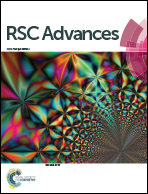Degradation of p-nitrophenol using CuO/Al2O3 as a Fenton-like catalyst under microwave irradiation
Abstract
CuO/Al2O3 was synthesized successfully by the impregnation-deposition method and used as a heterogeneous catalyst in a microwave assisted Fenton-like process (MW/FL). The morphology and physico-chemical properties of the CuO/Al2O3 catalyst were characterized using field emission scanning electron microscopy (FESEM), X-ray diffraction (XRD) and Brunauer–Emmett–Teller (BET) analysis. The degradation of p-nitrophenol (PNP) was investigated by different processes, including microwave irradiation (MW) alone, hydrogen peroxide (H2O2) oxidation under microwave irradiation without the catalyst (MW/H2O2), a Fenton-like (FL) process, a MW/FL process and a thermally-assisted Fenton-like (TH/FL) process. The results showed that the CuO/Al2O3 catalyzed MW/FL could generate more hydroxyl radicals (˙OH) and remove PNP more effectively compared to other processes. The effects of initial pH, dosage of H2O2 and catalyst, microwave power and radiation time, and PNP concentration on the removal efficiency were also studied. The results showed that 93% removal efficiency of PNP was obtained within 6 min under optimized conditions. Moreover, the catalyst had a good stability and reusability, thus expanding the scope of non-iron based catalysts in the Fenton-like reactions.


 Please wait while we load your content...
Please wait while we load your content...